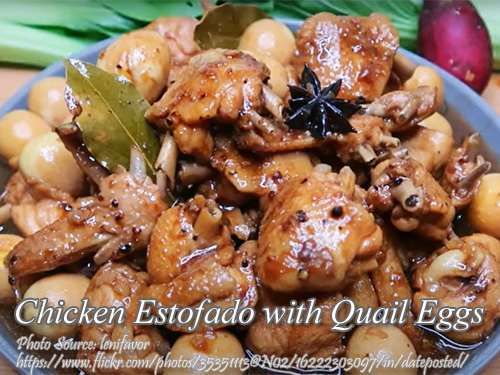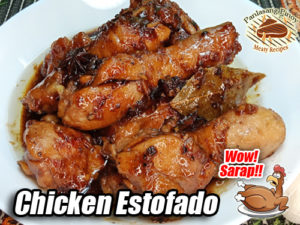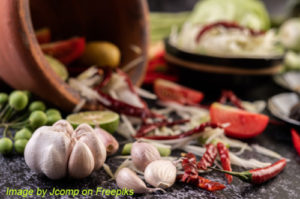Chicken estofado with quail eggs is a basic Filipino dish that is sure to tantalize your taste buds. This savory and fragrant recipe features tender chicken wings, hard-boiled quail eggs, and a mixture of flavorful spices that creates a dish that is both comforting and satisfying.
The dish has a rich and complex flavor profile that is a result of the combination of ingredients used. The garlic and onions create a aromatic base, while the black pepper adds a subtle spiciness. The bay leaves and star anise infuse the dish with a warm and slightly sweet flavor. While the oyster sauce and soy sauce furnish a savory umami taste. The addition of sugar helps balance out the flavors and adds a touch of sweetness.
The chicken wings are cooked until tender and juicy. The hard-boiled quail eggs add a unique texture and flavor that sets this dish apart from other chicken recipes. The sauce is rich and thick, coating each piece of chicken and egg with its scrumptious flavor.
Chicken Estofado with Quail Eggs: A Hearty Dish from My Childhood
I still remember the first time I watched my Tito Lando cook chicken estofado in my grandmother’s old kitchen. The air was thick with the aroma of garlic sizzling in oil, mixing with the sweet scent of star anise. He moved effortlessly, adding each ingredient as if telling a story—a story that I would soon make my own.
Growing up, this dish was a staple during weekend gatherings. My cousins and I would eagerly wait for the pot to be uncovered, revealing tender chicken wings bathed in a glossy, caramelized sauce, with plump quail eggs nestled in between. It was a dish that felt like home—warm, rich, and filled with love.
What Makes Chicken Estofado Special?
Estofado is a dish that showcases the Filipino way of blending flavors. It carries influences from Spanish estofado (which means stewed), but with a local twist. Unlike other tomato-based stews, this one leans on a combination of soy sauce, oyster sauce, and a touch of sugar, creating a perfect balance of sweet and savory. The addition of star anise and bay leaves gives it an aromatic depth that lingers in every bite.
Another unique feature of this version is the use of quail eggs. These tiny eggs, with their creamy texture, absorb the sauce beautifully, adding another layer of indulgence.
The Secret to Perfectly Tender Chicken Estofado
One of the most important steps in making a successful chicken estofado is sautéing the aromatics properly. Garlic and onions must be cooked until fragrant—this step builds the foundation of the dish’s flavor. My tito always said, “Huwag kang magmadali, pabanguhin mo muna ang kusina bago mo ilagay ang manok.” (Don’t rush; let the kitchen smell good first before adding the chicken.)
Browning the chicken before simmering is another essential technique. This process locks in the juices and helps create a deeper, richer taste. It also adds a slight caramelization to the skin, making each piece more flavorful.
The Role of Star Anise and Bay Leaves
Many home cooks might wonder why star anise and bay leaves are included in this dish. These spices are what set estofado apart from other Filipino chicken stews.
Star anise provides a warm, slightly sweet, licorice-like fragrance that complements the saltiness of the soy sauce. Meanwhile, bay leaves contribute an earthy, herbal note that enhances the overall aroma of the dish. My Lola Imelda always said that without these two, an estofado wouldn’t have its signature comforting smell.
How to Achieve a Thick, Flavorful Sauce
A good chicken estofado should have a thick and luscious sauce that clings to the chicken and quail eggs. The trick is in the slow simmering. Cooking on low heat allows the flavors to meld and the sauce to reduce gradually, achieving the perfect consistency.
The sugar plays a crucial role here. It doesn’t just add sweetness—it also helps caramelize the sauce, making it rich and glossy. Some households even add mashed bananas or pineapple for an extra layer of sweetness, but in our family, we keep it simple and let the soy sauce and sugar do the magic.
Bringing It All Together
Once the chicken is tender and the sauce has thickened, it’s time to add the quail eggs. These eggs are delicate, so they should be stirred in gently to avoid breaking. After a few more minutes of simmering, the dish is ready to be served.
There’s nothing quite like enjoying chicken estofado with a steaming plate of white rice. The way the sauce seeps into the grains, the tenderness of the chicken, and the slight chewiness of the quail eggs make every bite satisfying.
Food for Thought: The Evolution of Estofado
Though this dish is most commonly prepared with chicken or pork, variations exist across different regions of the Philippines. Some families add plantains or saba bananas, creating a sweeter contrast, while others prefer to include vinegar for a slight tang. No matter the version, the heart of the dish remains the same—it’s all about warmth, comfort, and bringing people together over good food.
Every time I cook this dish, I think of my Tito Lando, of childhood Sundays filled with laughter, and of the rich culinary traditions that make Filipino food so special. Now, it’s my turn to carry on the tradition, making sure that every spoonful of chicken estofado continues to tell a story—one of family, heritage, and the simple joys of home-cooked meals.
How To Cook Chicken Estofado with Quail Eggs
Ingredients
- 6 pcs chicken wings cut into serving pieces
- 1 tsp. ground black pepper
- 2 Tbsp. cooking oil
- 3 cloves garlic minced
- 2 pcs medium size onion minced
- 2 pcs bay leaf or laurel leaves
- 1 pc whole star anise
- 3 Tbsp. oyster sauce
- 2 Tbsp. soy sauce
- 1 Tbsp. sugar
- 1/2 cup water
- 20 pcs quail eggs hard boiled
Instructions
How To Cook Chicken Estofado with Quail Eggs
- Cut the chicken in serving pieces. Heat cooking oil in a pan and sauté garlic and onion until fragrant.
- Add chicken and stir. Stir the chicken for a few minutes or until slightly brown.
- Add black pepper, bay leaves, star anise, oyster sauce, sugar and soy sauce. Stir for a few seconds then add water.
- Bring to a boil and cover then simmer in low heat until the chicken is almost tender.
- Add the quail eggs and stir. Continue to cook until the sauce is reduced to your desired consistency. Serve hot with cooked rice.
Notes
Cooking Tips:
Sauté the Aromatics Properly for a Flavorful Base
Never rush the step of sautéing garlic and onions, as this creates the foundation of your dish’s flavor. Let the garlic turn lightly golden and the onions become translucent to bring out their natural sweetness. This slow-cooked base enhances the depth of your chicken estofado and makes the sauce more aromatic.Brown the Chicken for Extra Depth
Before simmering, sear the chicken pieces until they develop a light golden crust. This caramelization locks in the juices, giving the meat a richer taste and preventing it from becoming dry. Browning also adds an extra layer of umami, making the dish more flavorful overall.Simmer Slowly for a Thick and Tasty Sauce
Cooking on low heat allows the flavors to meld together while gradually thickening the sauce. A slow simmer helps the chicken absorb all the sweet, savory, and aromatic notes of the dish. Patience is key—rushing this step might leave you with a thin sauce that lacks the signature richness of a perfect chicken estofado.





